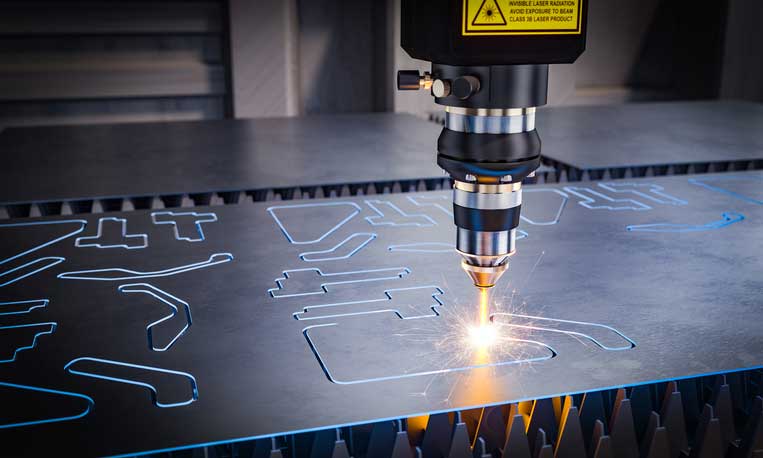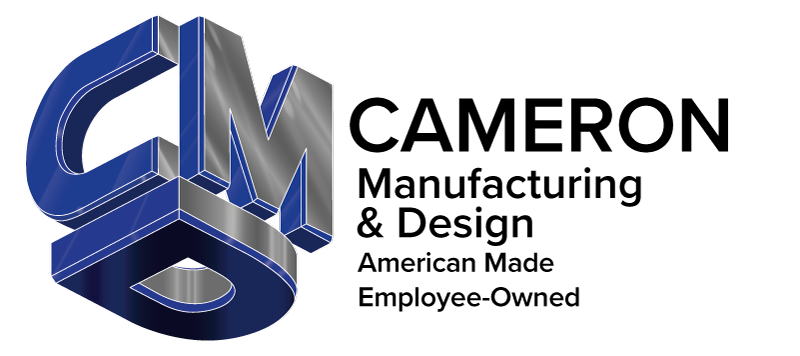
A variety of metal cutting processes can be used to create precise metal components in diverse shapes and sizes. Here is an overview of two types of metal cutting processes CMD uses to fulfill our clients’ project needs.
Laser Cutting
Laser cutting uses a thin, focused, powerful laser beam to cut or engrave a variety of materials including certain metals, as well as plastic, wood, and cardboard. This process results in the rapid heating, melting, and vaporization of unneeded material. For this reason, laser cutting is considered a subtractive manufacturing process.
Since it is extremely precise, laser cutting is often used for cutting intricate shapes and small holes into material. It generally has a processing tolerance of about 0.002 inches and a minimum cutting slit size of about 0.006 inches, making it capable of fulfilling intricate designs with incredibly small cuts and engravings. Laser cutting is also fast, making it one of the most highly efficient and effective types of metal cutting in existence.
Lasers can cut through thin to slightly thicker materials, usually from 0.12 inches to 0.4 inches in thickness. Laser cutting can be used on a variety of common metals, including aluminum, stainless steel, mild steel, and titanium. A coolant is commonly used throughout the process in order to avoid any negative effects caused by the heat of the laser.
In terms of industries, laser cutting is often used to achieve precision in automotive or aerospace applications. It can also be used for enhanced safety while cutting in hazardous environments, for larger projects like nuclear decommissioning.
Waterjet Cutting
Waterjet cutting is also a subtractive manufacturing technique and uses pressurized water focused on a minuscule point to cut through a material. It often uses an abrasive like garnet to aid in cutting and runs at extremely high pressures such as 50,000–60,000 psi. Like other CNC machines, waterjets are controlled by a CAD program that dictates the tool’s path, speed, cut depth, and more.
Waterjet cutting is known for its cost-effectiveness, versatility, and high efficiency. This technique is gaining fast popularity as more and more engineers and manufacturers adopt it for its ability to cut through thicker materials. Waterjet cutting doesn’t have many limits on which materials, considering their hardness and thickness, it can cut through. This also means that thin materials can be stacked in order to cut through multiple pieces at once, improving efficiency.
For context, many other industrial cutting methods can lose accuracy at ½-inch to 2 inches of thickness and only work on a specific subset of materials, while a waterjet is capable of cutting through up to 15 inches of a strong material like stainless steel reliably. This limits the need for secondary cutting or machining operations for several different types of projects using a variety of materials, saving time and money.
While many types of materials require heat for cutting and shaping, others need low-heat machining environments to avoid common issues like melting, warping, discoloration, tool wear, severe corrosion, or dimensional inaccuracy. Waterjet cutting presents a unique opportunity to cut through materials without generating any heat, making it ideal for certain materials. Between this quality and its ability to cut through thick materials, waterjet cutting can be used to cut virtually any organic or inorganic material.
Aluminum, brass, copper, steel, and titanium are all common metals that waterjets can cut through seamlessly. Additionally, other popular industrial materials like plastic, rubber, wood, tile, stone, or glass can also undergo waterjet cutting.
Laser vs. Waterjet Cutting
Now that we’ve covered these two popular types of metal cutting, which is more ideal for your next project? Find out the list of considerations that will help to determine the method used for your specific application below.
Both are considered highly efficient in projects spanning industries. However, each works better for different case scenarios and materials used.
Laser cutting can cut faster and with more precision than waterjet cutting. Lasers are also able to engrave and cut materials, while waterjets are only capable of cutting. For these reasons, laser cutting is often chosen for cutting or engraving thinner to medium-thickness metals with a quicker turnaround time.
However, work hardening is a concern with laser cutting, as the process introduces heat into parts. This limits the range of materials that can be laser cut, excluding all highly reflective metals from the list of possibilities.
Waterjet cutting is known for more versatility and the ability to work with a higher number of different materials. It can also cut through much thicker materials than laser cutting, including thicknesses up to two inches, while lasers max out at about 0.4 inches of thickness.
However, it has the potential to cause delamination, the separation of a material’s finish from its substrate. Waterjet cutting is also capable of less precision than laser cutting, with a minimum cutting slit size of about 0.2 inches, compared to a 0.006 minimum size produced by laser cutting. This makes waterjet cutting ideal for parts using thicker materials, requiring slightly less exactness, and metals more likely to warp when heated.
Cameron Manufacturing & Design Cuts Metal With Enhanced Precision
Cameron Manufacturing & Design is committed to providing high-quality metal components and excellent service to its customers across several industries, including food, beverage, dairy, rail & transit, automotive, and more. Offering both laser cutting and waterjet cutting capabilities, CMD can fulfill any custom machining, fabrication, or welding project with high accuracy and on-time delivery.
Reach out to one of our experts today to discuss how Cameron Manufacturing & Design can deliver precision metal components for any application.
Recent Posts
- Crafting Excellence Bridging Heavy Fabrication and Light Manufacturing
- What is Precision Sheet Metal Fabrication
- Unveiling the Power of Custom Manufacturing Equipment in NY
- Cameron Manufacturing & Design: Your Top Choice for CNC Laser Projects
- The Power of Precision Machining in Custom Metal Fabrication
Trust the CMD Team With Your Next Project
Our highly-skilled team across multiple areas of expertise will deliver a finished product that meets or exceeds your expectations.
